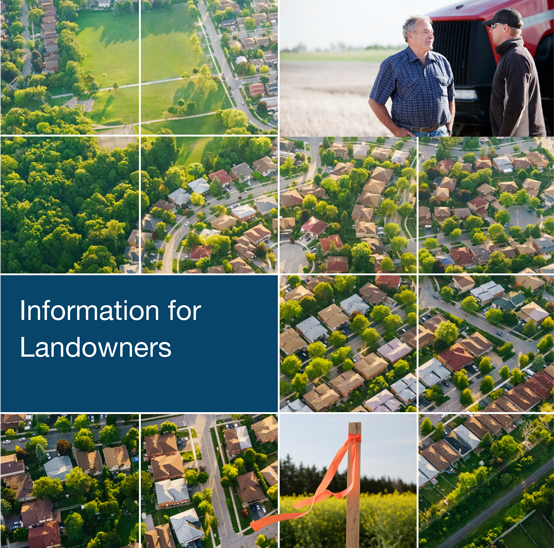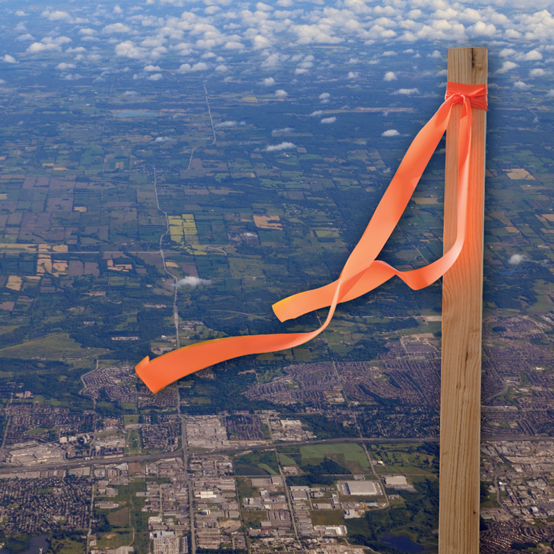Administrative Monetary Penalties: Information for Landowners
Administrative Monetary Penalties: Information for Landowners [PDF 5476 KB]
Copyright/Permission to Reproduce
Table of contents
- What are Administrative Monetary Penalties?
- How did AMPs come to be?
- Who do AMPs apply to?
- What is the penalty range?
- What criteria does the CER use to calculate the penalty?
- What actions can I take to avoid the risk of an AMP?
- What activities are authorized when crossing a pipeline right-of-way for agricultural purposes?
- If an AMP was issued, would the name of the landowner be published on the CER’s website?
- What are some examples of when an AMP could be issued to a landowner?
- Can I request a review if I don’t agree with an AMP I have received?
- Find out more

We work to explain our requirements to landowners to keep people, the environment and pipelines safe. The information in this booklet is intended to help everyone living and working near pipelines to understand their roles and responsibilities and to answer some common questions about administrative monetary penalties.

What are Administrative Monetary Penalties?
Administrative Monetary Penalties or AMPs are financial penalties the Regulator can impose on companies or individuals for not following any CER legislative requirement intended to promote safety or environmental protection. They are a powerful tool both to prevent harm and to deter future non-compliance.
The Canada Energy Regulator (CER) is focused on preventing unsafe situations from happening. Should the CER be required to use enforcement actions, it would apply the most appropriate enforcement tool depending on the situation. The goal is to make the situation safe as quickly and effectively as possible. AMPs do not replace any of the CER’s other enforcement tools. Instead, they give the CER another way to keep people safe and protect the environment when voluntary or facilitated measures aren’t working.
How did AMPs come to be?
In July of 2012, the Government of Canada passed the Jobs, Growth and Long-term Prosperity Act.
As a part of this, the NEB Act in force at the time, was changed, requiring it to establish a system of administrative monetary penalties. On July 3, 2013, the Administrative Monetary Penalties Regulations (AMP Regulations) came into force allowing the CER to begin issuing AMPs to companies or individuals not meeting regulatory requirements.
On February 26, 2016, changes to the Canada Oil and Gas Operations Act came into effect to also allow the CER to issue AMPs for designated violations under that legislation.
On August 28, 2019, the National Energy Board Act was repealed and replaced with the Canadian Energy Regulator Act. The CER Act continues to have provisions regarding AMPs (CER Act, sections 115-135).
Who do AMPs apply to?
AMPs can be applied to both companies and individuals. The CER’s Enforcement Policy says that AMPs could be used when other enforcement tools such as letters, orders or voluntary commitments are not working.
Farmers and landowners could be considered either as companies or individuals depending on how their business is set up. The CER has the discretion to decide whether an AMP will be issued to a company, an individual within a company, or an individual separately.
What is the penalty range?
There are two separate penalty ranges: one for companies and one for individuals. The CER Act sets out the maximum daily penalties for both individuals and companies.
- For individuals: the daily penalty could range from $250 to a maximum of $25,000 per violation.
- For companies: the daily penalty could range from $1,000 to a maximum of $100,000 per violation.
For individuals:

the daily penalty could range from $250 to a maximum of $25,000 per violation.
For companies:

the daily penalty could range from $1,000 to a maximum of $100,000 per violation.
What criteria does the CER use to calculate the penalty?
To calculate the penalty, the CER considers the specific circumstances surrounding the violation. These circumstances are assigned “gravity values,” which can either raise or lower the penalty. Schedule 2 of the AMPs Regulations outlines all the potential gravity levels and the corresponding penalty amounts. When considering issuing an AMP to landowners, the CER looks at things such as:
- the nature and seriousness of the violation;
- if there was negligence or the intention to do harm;
- the company or individual’s level of cooperation; and
- the safety history including if there have been repeat offences.

What actions can I take to avoid the risk of an AMP?

There are several things you can do to avoid enforcement actions:
- Visit the work site ahead of time and looking for pipeline warning signs or marker posts.
- Contact the pipeline company for a copy of their guidelines for working near their pipeline.
- Obtain the pipeline company’s written approval for the activity.
- Contact the one-call centre at Click Before You Dig or the pipeline company to have the pipeline located;
- Be on-site when the pipe is located to understand the meaning of the pipeline markers.
- Give three working days’ notice to the pipeline company prior to the start of the approved activity unless otherwise agreed on by the pipeline company and the landowner.
The CER audits companies’ Public Awareness programs periodically to confirm they are meeting the requirements to inform people on how they can keep pipelines safe.
What activities are authorized when crossing a pipeline right-of-way for agricultural purposes?
Operating a vehicle or mobile equipment across a pipeline is prohibited unless the operation is authorized through the Damage Prevention Regulations or a Commission order, or the vehicle or mobile equipment is operated within the travelled portion of a highway or public road.
Agricultural Activities:
The operation across the pipeline of a vehicle or mobile equipment that is used to perform an agricultural activity is authorized if the following conditions are met:
- The loaded axle weight and tire pressures of the vehicle or mobile equipment are within the manufacturer’s approved limits and operating guidelines; and
- The point of crossing has not been identified by the pipeline company as being unsafe to cross or cultivate over. Agricultural activity means the production of crops and the raising of animals and includes pasturing and cultivation activities such as tillage, plowing, disking and harrowing.
Ground Disturbance:
Ground disturbance is any activity that involves:
- the soil being disturbed or displaced to a depth of 30 cm or more;
- any reduction of the earth cover over the pipeline; or
- cultivation to depths of 45 cm or more.
Some of these activities include digging, clearing and stump removal, subsoiling and driving in fence posts. If undertaking an activity that causes a ground disturbance, that activity must be authorized by the pipeline company.

If an AMP was issued, would the name of the landowner be published on the CER’s website?
As a part of its commitment to keep people informed, the CER posts enforcement actions on its external website. For AMPs, this would include information on the violation and the amount of the penalty. The CER posts the name of any company that receives a Notice of Violation (NOV). An NOV is issued to an individual or company to let them know a violation has occurred. The decision to disclose the name of an individual is made on a case-by-case basis. However, for most violations, the name of the individual will not be proactively shared.
What are some examples of when an AMP could be issued to a landowner?
Examples of situations that could result in an AMP being issued to a landowner are:
- Ground disturbance within the prescribed area without authorization;
- Any reoccurrence of unauthorized crossings or activities; or
- Knowingly disobeying direction given by the CER in any certificate, licence, permit, leave or exemption under the CER Act.
The main ways the CER follows up on safety concerns or infractions that have been identified on a landowner’s property include:
- Ensuring the landowner voluntarily corrects the identified issue; or
- Facilitating the correction through a letter; or
- Facilitating a correction through the use of tools such as orders or AMPs.
The CER is committed to working with landowners to resolve any safety or environmental issues so that enforcement measures do not need to be used. The CER also provides oversight of the obligation of pipeline companies by auditing their Public Awareness programs periodically to confirm they are meeting the requirements to inform landowners on how they can keep pipelines safe.
If landowners have questions about what activities are safe near pipelines, they can contact the appropriate pipeline company or the CER directly for more information at 1-800-899-1265 or via email at dpinfo@cer-rec.gc.ca.
Can I request a review if I don’t agree with an AMP I have received?
Yes. A company or individual can request a review if they feel the AMP was not appropriate for the violation in question. In this review they can ask the Commission to review the amount of the penalty, the facts of the violation or both.
The request for a review must occur within 30 days of receiving the Notice of Violation. The initial request requires a high level account of why a review is being requested. Detailed information of the following key steps and timelines would be included in the review package.
If a review is not requested within the initial 30 day period, the recipient is required to pay the penalty amount.
For more information on the AMPs process, please visit the CER website for the AMPs Process Guide.
The CER will enforce regulatory requirements to obtain compliance, deter future non-compliance, and prevent harm by using the most effective tool or tools available.”
CER Enforcement Policy

Find out more
Find out more about the Canada Energy Regulator
by visiting us online.
Be sure to follow us on social media for the latest updates.
For copies of any CER publication or for more information, contact us:
ONLINE: www.cer-rec.gc.ca
EMAIL: info@cer-rec.gc.ca
TOLL FREE: 1-800-899-1265
Write us or visit our library at:
Canada Energy Regulator
210-517 10 Ave SW
Calgary AB T2R 0A8
- Date modified:
